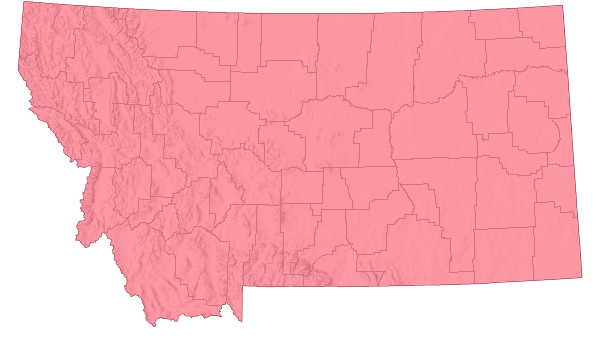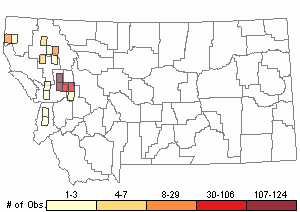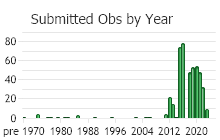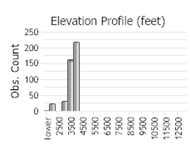View in other NatureServe Network Field Guides
NatureServe
Montana
Utah
Wyoming
Idaho
Wisconsin
British Columbia
South Carolina
Yukon
California
New York
American Water-lily - Nymphaea odorata
Other Names:
Fragrant Water-lily, American White Water-lily
State Rank Reason (see State Rank above)
Nymphaea odorata is exotic in Montana (Wiersema in Flora of North America [FNA] 1997; Booth and Wright 1966). It is listed as a noxious weed in Missoula County, but is not designated as State-noxious (Slotnick et al. 2020). Plants in Montana are subspecies odorata (Wiersema in FNA; Lesica et al. 2012). Nymphaea odorata was introduced from the eastern United States for its ornamental appeal (Wiersema in FNA; Lesica et al. 2012). In some states and provinces Nymphaea odorata is considered invasive. A conservation status rank is not applicable (SNA) because exotic plants are not a suitable target for conservation activities.
General Description
PLANTS: Aquatic perennials with floating leaves and floating, showy flowers. Rhizomes are 2-3 cm in diameter, long, branched, creeping, and covered with short, black hairs. Sources: Lesica et al. 2012; DiTomaso and Healy 2003.
LEAVES: Large, floating, nearly orbicular, and 8-20 cm long. Leaves are green above and green to purple below. Margins are entire (smooth) and bases are cordate-shaped, like the top of a heart. Petioles are long and attached to a rhizome. Sources: Wiersema in FNA; Lesica et al. 2012.
INFLORESCENCE: Singular flowers have at least 17 white, showy petals, 4 green or reddened sepals of at least 3 cm long, and float with a long flower stem (peduncle). Sources: Wiersema in FNA; Lesica et al. 2012.
Phenology
Flowering occurs from spring to summer, or into early fall for more southern populations (DiTomaso and Healy 2003).
Diagnostic Characteristics
In Montana three genera represent the “water-lily family”: Brasenia (water shield), Nuphar (pond-lily), and Nymphaea (water-lily).
Brasenia species have round to elliptical floating leaves with no basal sinus or split in the leaf.
Nuphar species have heart-shaped floating leaves that appear split, yellowish sepals, and inconspicuous petals.
Nymphaea species have heart-shaped floating leaves that appear split, 4 green sepals, and numerous white petals. In Montana Nymphaea odorata and Nymphaea leibergii differ in their fragrance, sepal length, and number of petals. Nymphaea odorata has fragrant flowers (Hitchcock et al. 1964), at least 17 white petals, and sepals of at least 3 cm long (Lesica et al. 2012). Nymphaea leibergii lacks fragrant flowers (Hitchcock et al. 1964), has 7 to 15 petals, and sepals of 3 or less cm long (Lesica et al. 2012).
Our plants in Montana are Nymphaea odorata subspecies odorata.
Species Range
Montana Range
Range Descriptions

 Non-native
Non-native
Range Comments
Introduced from the eastern United States, Fragrant Water-lily is found in all western states except Wyoming (DiTomaso and Healy 2003). Two subspecies (tuberosa and odorata) are recognized in the United States, and where populations overlap intermediate forms develop (FNA 1997).
For maps and other distributional information on non-native species see:
Nonindigenous Aquatic Species Database from the U.S. Geological Survey
Invasive Species Habitat Tool (INHABIT) from the U.S. Geological Survey
Invasive Species Compendium from the Centre for Agriculture and Bioscience International (CABI)
EDDMapS Species Information EDDMapS Species Information
Observations in Montana Natural Heritage Program Database
Number of Observations: 463
(Click on the following maps and charts to see full sized version)
Map Help and Descriptions
Relative Density

Recency



 (Observations spanning multiple months or years are excluded from time charts)
(Observations spanning multiple months or years are excluded from time charts)
Habitat
Acidic to alkaline lakes and ponds in valleys (DiTomaso and Healy 2003; Lesica 2012).
Ecological Systems Associated with this Species
Ecology
Fragrant Water-lily has rhizomes that can tolerate some desiccation (DiTomaso and Healy 2003). Plants can also become abundant, shading out native plants,and impairing recreation.
POLLINATORS The following animal species have been reported as pollinators of this plant species or its genus where their geographic ranges overlap:
Bombus vagans (Colla and Dumesh 2010).
Management
The Missoula County Weed Board received a petition on March 3, 2020 to list Fragrant Water-lily as a noxious county plant (Slotnick et al. 2020). The County Weed Board reviewed the status and known impacts of the species in neighboring Montana counties, states, and provinces and recommended that listing as noxious was in the best interest of the public (Slotnick et al. 2020). On December 10, 2020 the Board of Missoula County Commissioners passed a resolution to designate
Nymphaea odorata Aiton as noxious in Missoula County, Montana (Slotnick et al. 2020).
Contact information for Aquatic Invasive Species personnel:Montana Fish, Wildlife, and Parks Aquatic Invasive Species staffMontana Department of Natural Resources and Conservation's Aquatic Invasive Species Grant ProgramMontana Invasive Species Council (MISC)Upper Columbia Conservation Commission (UC3)References
- Literature Cited AboveLegend:
 View Online Publication
View Online Publication Booth, W. E. and J. C. Wright. 1966. Flora of Montana-Part II: dicotyledons. Montana State University, Bozeman, MT. 305 pp.
Booth, W. E. and J. C. Wright. 1966. Flora of Montana-Part II: dicotyledons. Montana State University, Bozeman, MT. 305 pp. Colla, S.R. and S. Dumesh. 2010. The bumble bees of southern Ontario: notes on natural history and distribution. Journal of the Entomological Society of Ontario 141:39-68.
Colla, S.R. and S. Dumesh. 2010. The bumble bees of southern Ontario: notes on natural history and distribution. Journal of the Entomological Society of Ontario 141:39-68. DiTomaso, J.M. and E.A. Healy. 2003. Aquatic and riparian weeds of the West. Regents of University of California, Division of Agriculture and Natural Resources, Publication 3421.
DiTomaso, J.M. and E.A. Healy. 2003. Aquatic and riparian weeds of the West. Regents of University of California, Division of Agriculture and Natural Resources, Publication 3421. Flora of North America Editorial Committee. 1997. Flora of North America North of Mexico. Volume 3. Magnoliophyta: Magnoliidae and Hamamelidae. Oxford University Press, Inc., New York, NY. xxiii + 590 pp.
Flora of North America Editorial Committee. 1997. Flora of North America North of Mexico. Volume 3. Magnoliophyta: Magnoliidae and Hamamelidae. Oxford University Press, Inc., New York, NY. xxiii + 590 pp. Hitchcock, C. L., A. Cronquist, M. Ownbey, and J. W. Thompson. 1964. Vascular Plants of the Pacific Northwest. Part 2: Salicaceae to Saxifragaceae. University of Washington Press, Seattle. 597 pp.
Hitchcock, C. L., A. Cronquist, M. Ownbey, and J. W. Thompson. 1964. Vascular Plants of the Pacific Northwest. Part 2: Salicaceae to Saxifragaceae. University of Washington Press, Seattle. 597 pp. Lesica, P., M.T. Lavin, and P.F. Stickney. 2012. Manual of Montana Vascular Plants. Fort Worth, TX: BRIT Press. viii + 771 p.
Lesica, P., M.T. Lavin, and P.F. Stickney. 2012. Manual of Montana Vascular Plants. Fort Worth, TX: BRIT Press. viii + 771 p. Slotnick, J., D. Strohmaier, and J. Vero. 2020. A resolution to designate fragrant water-lily (Nymphaea odorata Aiton) as a noxious weed in Missoula County. Board of County Commissioners, Missoula Co., MT: Resolution No. 2020-117. 1 p.
Slotnick, J., D. Strohmaier, and J. Vero. 2020. A resolution to designate fragrant water-lily (Nymphaea odorata Aiton) as a noxious weed in Missoula County. Board of County Commissioners, Missoula Co., MT: Resolution No. 2020-117. 1 p.
- Additional ReferencesLegend:
 View Online Publication
View Online Publication
Do you know of a citation we're missing? Lesica, P., M.T. Lavin, and P.F. Stickney. 2022. Manual of Montana Vascular Plants, Second Edition. Fort Worth, TX: BRIT Press. viii + 779 p.
Lesica, P., M.T. Lavin, and P.F. Stickney. 2022. Manual of Montana Vascular Plants, Second Edition. Fort Worth, TX: BRIT Press. viii + 779 p.
- Web Search Engines for Articles on "American Water-lily"





